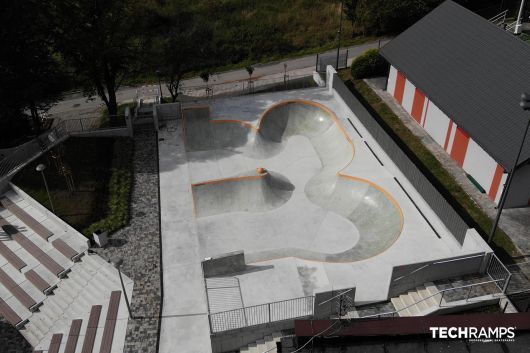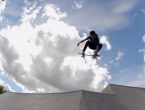SKATEPARK DESIGNS
NEWS
- Skateparks without rubbish - Ministry of Sports introduces new standards
- New guide will help build safe skateparks
- New standard for construction of public skateparks
- The concrete skatepark in Scinawa is coming!
- Surfskate - concrete surfing
- Why invest in a skatepark in your city?
- #MeetOurCrew - Lukasz Legutek
- SK8isGR8 - Skateboard Film Festival, Warsaw (2024)
- DUNK&GRIND - Shuvary Park Kraków (2024)
- New skatepark in Rybnik: construction underway
Why don\'t we make skateparks with prefabricated elements?

Prefabricated skateparks are built from prefabricated, factory-made components. Prefabricated elements are usually various types of ramps, stairs, handrails and other obstacles, which are made of materials such as concrete, metal or plastic.
Due to the continuous improvement of our projects and attention to the high quality and longevity of our facilities, we have decided to abandon skateparks with prefabricated elements.
The first reason for this decision is design limitations. Precast elements are usually produced in standard sizes and shapes, which can limit the possibilities and creativity of our designers. Unlike cast-in-place concrete, where designers have more freedom to shape the space, prefabricated elements may not always perfectly meet the needs of skatepark users. And it is meeting riders\' expectations and social listening that we care most about in our operations and communications.
Another impetus for change was the visible seams and joints that were visible on the facilities. Prefabricated elements must be joined in place, which can lead to the appearance of seams between segments. These seams can not only be visible, but can also affect the smoothness of the ride, and can expand or crack over time, requiring additional maintenance.
As a company that has \"professionalism\" written into its values, we want to commission high-quality facilities, because it is combined with a level of safety for users. Although the concrete used in prefabricated buildings is of high quality, the way the individual elements are joined together can affect the overall strength and durability of the structure. The elements can move or settle unevenly, which increases the risk of damage and can be dangerous for people using the facilities.
Another reason is the additional costs that can be a burden to our customers. Prefabricated elements must be transported to the site, which can be costly, especially if the skatepark is being built in a remote location. In addition, they require adequate infrastructure for unloading and assembly, which can also increase project costs.
The skatepark must also be properly adapted to the terrain on which it is located. Prefabricated elements may not be ideally suited to the irregularities and peculiarities of the terrain. This can lead to problems with the fit and stability of the structure.
Skateparks are no longer just gray structures, but aesthetic impressions are equally important. Although modern technologies allow the creation of aesthetically appealing prefabricated structures, parks made entirely of cast-in-place elements often look more cohesive and stylish.
For these reasons, although prefabricated skateparks offer a quick and sometimes economically attractive option, many communities and designers may prefer to build cast-in-place skateparks, which offer greater durability, better environmental fit and more personalized design solutions.
If we have convinced you to build a skatepark made of 100% concrete - get back to projekty@techramps.com and we will create a skatepark that will be a community dream come true!
See also: Why Techramps?

